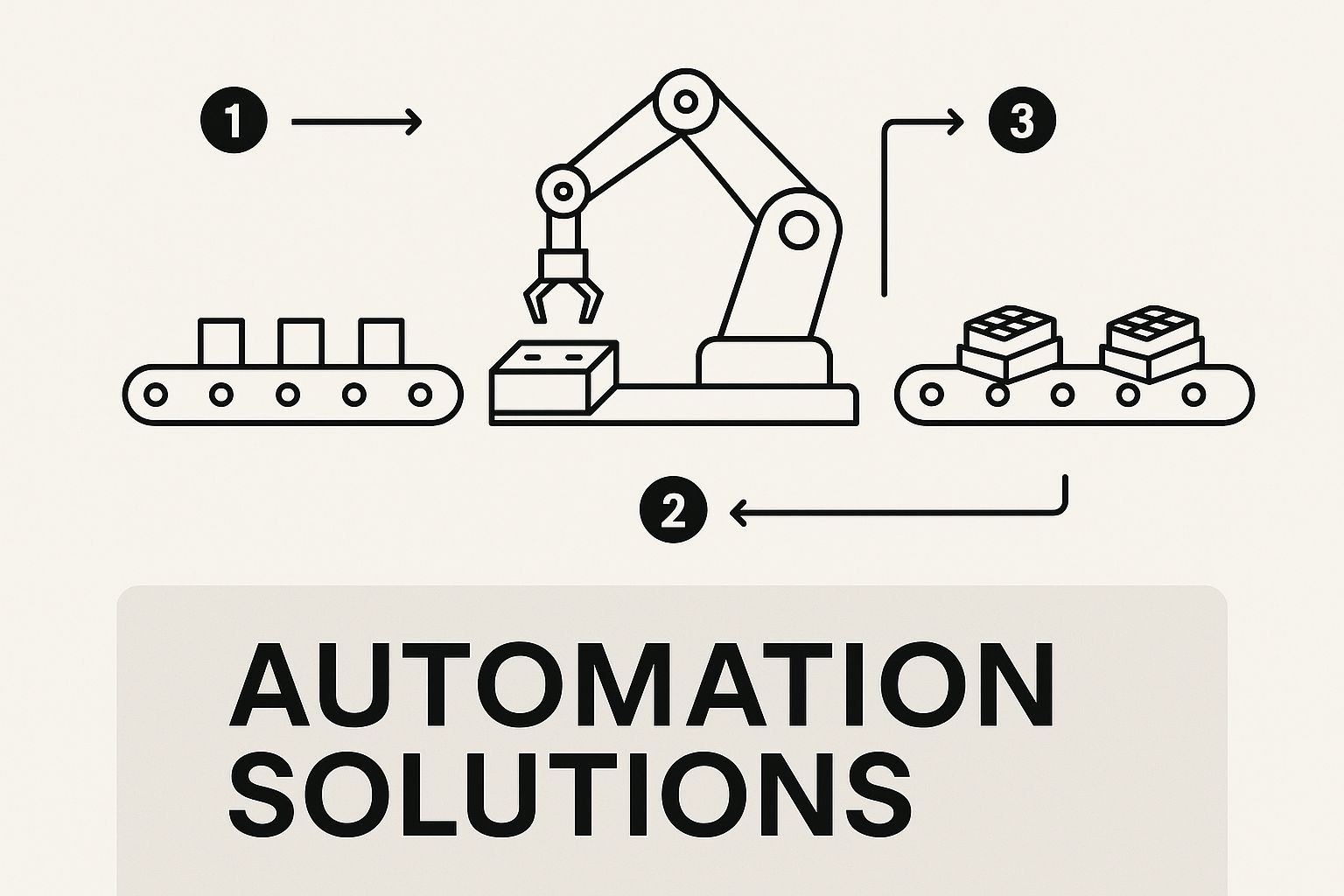How to Reduce Operational Costs That Last
Cutting operational costs isn't just about making frantic, last-minute budget slashes. It's about building a smart, sustainable system for continuous optimization. The real work begins with a hard look at your current expenses to figure out what’s actually driving growth versus what’s just draining your resources. From there, you can use technology and smart planning to secure your company's long-term financial health.
Your Blueprint for Smart Cost Reduction

Learning how to reduce operational costs the right way requires a mental shift. You need to move from reactive, short-term thinking to deliberate, long-term control. Think of it less as hacking away at your budget and more as building a resilient, efficient, and ultimately more profitable business. This guide is your blueprint for making that happen.
The journey doesn't start with a spreadsheet. It starts with a simple question: which of our costs are actually fueling growth, and which are just waste? For instance, investing in a new marketing channel that consistently brings in high-value customers is a 'growth cost.' But paying for five different software subscriptions that all do basically the same thing? That's a 'wasteful cost.' The goal here is simple: eliminate the waste to better fund the growth.
The Pillars of Sustainable Savings
An effective cost-reduction strategy stands on a few core pillars. If you neglect any one of them, you're likely setting yourself up for temporary fixes instead of lasting change.
- Deep Expense Analysis: First things first, you have to know exactly where every dollar is going. This means a full-blown audit of all your expenses—from rent and utilities to every single software license and supplier contract.
- Process Optimization: So many hidden costs are tangled up in clunky, inefficient workflows. Streamlining how your team gets work done is one of the most direct paths to savings. You can get started by learning more about how to improve operational efficiency here: https://makeautomation.co/how-to-improve-operational-efficiency/
- Technology Adoption: Modern tools are no longer optional. Automation and Artificial Intelligence (AI) have been game-changers, driving some of the biggest operational cost reductions we've seen globally. In fact, some data shows businesses that go all-in on these technologies can see up to 30% cost savings.
- Strategic Partnerships: Your relationships with vendors and suppliers are a goldmine for potential savings. Smart negotiation and building genuine partnerships can lead to some serious financial benefits down the line.
True cost optimization isn't a one-time project; it's a cultural shift. It's about empowering your team to constantly look for smarter, more efficient ways to operate without sacrificing quality or growth potential.
To give you a clearer picture, here’s a quick overview of how these core strategies fit together.
Core Cost Reduction Strategies at a Glance
| Strategy Pillar | Primary Focus | Potential Impact |
|---|---|---|
| Expense Analysis | Gaining full visibility into all spending categories. | Identifies immediate "quick wins" and wasteful spending. |
| Process Automation | Eliminating repetitive manual tasks and workflows. | Frees up employee time, reduces errors, and boosts productivity. |
| Vendor Optimization | Renegotiating contracts and consolidating suppliers. | Lowers direct costs and improves service-level agreements. |
| Staffing Strategy | Aligning team structure with strategic business goals. | Improves resource allocation and maximizes employee value. |
| Ongoing Monitoring | Implementing systems to track costs and KPIs continuously. | Prevents cost creep and fosters a culture of financial awareness. |
This table neatly summarizes the foundational elements of a robust cost-management plan.
This framework sets the stage for the practical, actionable strategies we’ll cover next. By approaching cost management with a clear plan, you move beyond simple belt-tightening and start building a more robust and financially sound organization. For more ideas, you might also find these 10 smart ways to reduce operating costs helpful.
Finding Savings with an Expense Audit
Before you can start slashing your budget, you need a crystal-clear picture of where every dollar is going. Trying to cut operational costs without a deep-dive expense audit is like trying to navigate a maze blindfolded. You might stumble upon some savings, but you'll hit a lot of dead ends first.
The first step is to get granular. Forget broad categories like "software" or "marketing" for a moment. We need to break everything down, line by line. The goal is to move from a vague sense of your spending to a precise understanding of every single outflow. This is where you’ll find the hidden leaks that are quietly draining your budget.
Categorizing Your Business Expenses
To make sense of it all, you'll want to sort your costs into a few simple buckets. This isn't just an accounting exercise; it makes spotting patterns and opportunities much easier down the road. While every company is unique, most of your expenses will likely fit into one of these groups:
- Fixed Costs: These are your predictable, recurring expenses that don’t change much from month to month. Think of things like office rent, insurance premiums, and the base salaries for your team.
- Variable Costs: These costs go up and down with your business activity. This bucket holds things like raw materials for production, sales commissions, and shipping costs. The more you sell or produce, the higher they get.
- Semi-Variable Costs: This is the messy-but-important middle ground. It could be a utility bill with a fixed base rate plus usage charges, or a salesperson's base salary plus their performance-based commission.
Pulling this data together might sound like a chore, but you don't need fancy tools. A simple spreadsheet or your existing accounting software will do the trick. The key is to be consistent. I always recommend tracking everything for at least three to six months to get a reliable baseline and identify real trends.
The image below shows how identifying areas of high manual effort, a common discovery during an expense audit, can point directly to opportunities for automation.

As you can see, labor-intensive processes—often a major variable cost—are prime candidates for automation solutions that can deliver significant long-term savings.
Digging Deeper into the Data
Once you’ve got everything categorized, the real work begins. It’s time to put every line item under the microscope and ask some tough questions. Don't just look at the numbers; investigate the why behind them.
For example, when you review your software subscriptions, you might find you're paying for three different project management tools when your team really only uses one. Or you might uncover "zombie subscriptions"—those services you signed up for with a free trial and forgot to cancel. These small leaks add up fast. Just look at the video tech company Kaltura, which managed to slash its observability costs by a staggering 60% just by moving its logging solution to a more efficient platform. The savings are often hiding in plain sight within your tech stack.
An expense audit isn't about judging past decisions. It's about gathering intelligence to make smarter decisions tomorrow. Treat it as a data-gathering mission, not a blame game.
From Analysis to Actionable Strategy
After your deep dive, you should have a solid list of potential savings targets. Now, you need to prioritize. I find a simple matrix is the best way to do this. Rank each potential cut based on two factors: how much you could save and how easy it is to implement.
| Potential Saving | Ease of Implementation | Priority | Example |
|---|---|---|---|
| High | Easy | Top Priority | Cancel redundant software subscriptions. |
| High | Hard | Strategic Project | Renegotiate a major supplier contract. |
| Low | Easy | Quick Win | Switch to energy-efficient light bulbs. |
| Low | Hard | Low Priority | Overhaul a deeply embedded legacy system. |
This simple grid helps you focus your energy where it will have the biggest, fastest impact. Your "Top Priority" and "Quick Win" items are where you should start. For instance, manual invoice processing is a common time-sink for many businesses. Learning how to automate invoice processing can be a high-impact, relatively easy win that delivers immediate savings.
With this data-backed foundation, you're no longer guessing. You have a prioritized roadmap to not just cut costs, but to strategically reinvest those resources into building a more resilient and profitable business.
Automating Tasks to Boost Efficiency
Repetitive, manual tasks are the silent killers of both your budget and your team's morale. They eat up countless hours and, worse, open the door to human errors that can be surprisingly costly to fix. Shifting these key processes to automated systems isn't just a good idea—it's one of the most direct and powerful ways to reduce your operational costs.
This isn't about replacing people. It's about empowering them. When you let technology handle the tedious, rule-based work, you free up your team to focus on things that actually grow the business, like innovation, customer relationships, and strategic planning.
Finding the Best Opportunities for Automation
The first step is figuring out which tasks are holding you back the most. You're on the hunt for processes that are repetitive, time-consuming, and prone to error. This kind of optimization is a globally recognized method for cutting costs, often borrowing from frameworks like Lean and Kaizen and pairing them with modern tools like Robotic Process Automation (RPA).
Here are some of the most common—and impactful—areas to start with:
- Financial Admin: Think about all the time spent on invoice processing, expense report approvals, and payroll. These are prime candidates for automation.
- Customer Service: You can easily set up automated email responses for common questions, use chatbots to handle initial inquiries, and implement systems that route support tickets to the right person. These small changes can dramatically improve your team's efficiency.
- Data Entry & Management: If a task involves copying information from one system to another, like updating your CRM with new leads, it should be automated. Period.
- HR & Onboarding: The entire new-hire process, from sending out standard paperwork to scheduling orientation and provisioning system access, can be streamlined into a slick digital workflow.
The real goal here is to find the friction in your daily operations. Where are the bottlenecks? Where do simple mistakes cause big headaches? Those are your automation starting points.
By systematically tackling these tasks, you can slash the time and resources needed for day-to-day operations. For a more detailed roadmap, our guide on how to automate repetitive tasks is a great resource.
What Is Robotic Process Automation (RPA)?
One of the most effective tools for this is Robotic Process Automation (RPA). RPA uses software "bots" that are programmed to mimic human actions on a computer. They can log into applications, enter data, perform calculations, and complete entire tasks just like a person would, only faster and with zero errors.
The image below gives you a glimpse into a typical RPA workflow, showing how a bot can be programmed to follow a series of rule-based steps across different applications.

You can see how the bot moves through a predefined sequence—like reading an email, pulling data from an attached invoice, and entering that information into an accounting system—to complete a process from start to finish without any human intervention.
Real-World Examples of Automation at Work
Theory is one thing, but seeing how automation solves real business problems is where it really clicks.
Let's look at a few practical scenarios:
- Automated Invoicing: A marketing agency was losing nearly 20 hours per week to manually creating and sending client invoices. By setting up an RPA bot, they automated the whole thing. The bot now pulls project data from their management software, generates a branded invoice, and emails it to the right person. That one change saved them over 80 hours a month and let an employee focus entirely on managing client accounts.
- Digital Employee Onboarding: A growing tech company was drowning in paperwork for new hires. They built a digital workflow that kicks off automatically when a candidate signs their offer letter. It sends welcome emails, creates IT tickets for equipment, and enrolls the new employee in training. This took their administrative onboarding time from 5 hours per hire down to just 30 minutes.
- Lead Data Enrichment: A sales team was wasting valuable time digging up contact info for new leads. They integrated a tool that automatically enriches new leads in their CRM with data from professional networking sites and business databases. Their reps now get complete, accurate info instantly, letting them focus on selling instead of research.
Each of these examples gets to the heart of what automation does best: it turns a high-effort, low-value task into an efficient, hands-off process. That’s the essence of working smarter to lower your operational costs and build a more scalable business.
Rethinking Your Vendor and Supplier Contracts
Your vendor contracts are a hidden goldmine for savings. Too often, they’re signed, filed away, and forgotten. But if you're serious about lowering operational costs, you have to treat procurement as a strategic advantage, not just another line item on the expense report. It’s all about becoming a smarter, more prepared negotiator who knows a signature isn’t the end of the conversation—it's the start of a partnership.
Many businesses get stuck in the "set it and forget it" mindset with their vendors. But your needs change, market rates go up and down, and your value as a long-term customer grows every year. Making it a habit to review and renegotiate these agreements is one of the most direct ways to boost your bottom line.
Start by Auditing Your Existing Contracts
Before you can ask for a better deal, you need to know exactly what you’re paying for. The first step is to gather every single active vendor and supplier agreement you have. Don’t just look at the big-ticket items; dig into everything from software subscriptions and professional services to raw material suppliers and even your utility providers.
Once you have the documents, it’s time to put on your detective hat. You're looking for specific details that can give you leverage or uncover quick wins:
- Auto-Renewal Clauses: Are you locked into automatic renewals? Find the notification deadlines you need to hit to change or cancel the terms. Missing one of these dates can lock you into another year of bad pricing.
- Service Level Agreements (SLAs): Is the vendor actually delivering on their promises? If they’re missing their targets, you have a powerful, data-backed reason to ask for a discount or better terms.
- Usage and Scope: Are you paying for services or software licenses you no longer need? A shocking number of companies pay for "shelfware"—licenses that just sit on a virtual shelf, completely unused. A quick audit can turn these into immediate savings.
- Price Increase Terms: Check the contract for language about annual price hikes. Knowing how and when your rates can go up helps you get ahead of the conversation.
This audit gives you the hard data you need to negotiate from a position of strength, not just making blind requests.
Your loyalty is a bargaining chip. Don’t be afraid to use it. Start the conversation by highlighting the relationship: “We’ve really enjoyed working with you for the past five years, but our budget is tightening. What can we do together to bring this cost down?”
The Power of Consolidation and Strategic Partnerships
Spreading your business across dozens of suppliers creates an administrative nightmare and kills your bargaining power. One of the most effective moves you can make is to consolidate your spending with fewer, higher-quality vendors. The moment you increase your order volume with a single supplier, you gain significant leverage.
Just think about it from their side. A larger, more consistent order is far more valuable and efficient for them to manage. This immediately opens the door to negotiating volume discounts, which can drastically lower your per-unit costs. Beyond price, consolidation simplifies your own procurement process, cutting down the administrative time spent juggling multiple relationships.
Building a true partnership goes beyond simple transactions. When a vendor sees you as a strategic partner, you can get access to more flexible payment terms, priority support, and even a say in their product development. It shifts the dynamic from a simple buyer-seller arrangement to an alliance where you’re both invested in making each other successful.
Effective Vendor Negotiation Tactics
Walking into a negotiation without a clear strategy is a recipe for failure. Just asking for a discount rarely works. You need to show up prepared with data, a list of alternatives, and a clear idea of what a "win" looks like for you.
To get you started, here’s a breakdown of a few proven tactics I’ve seen work time and time again.
| Negotiation Tactic | Description | When to Use |
|---|---|---|
| The Data-Driven Approach | Presenting clear research on competitor pricing or documented service failures (like missed SLAs). | This should be your default strategy. It grounds the conversation in objective facts, not opinions. |
| The Long-Term Commitment | Offering to sign a longer contract in exchange for a lower monthly rate or locked-in pricing. | Use this when you're confident in the vendor and want to secure predictable costs for the next few years. |
| The Bundling Play | Asking for a discount by adding more services or products from the same vendor. | This works especially well with large providers (like telecom or software companies) that have a wide range of offerings. |
| The Walk-Away Option | Having a viable alternative supplier ready and being prepared to switch if your terms aren't met. | This is a high-stakes move. Reserve it for non-critical suppliers where you have a strong, vetted backup plan. |
Choosing the right tactic for the situation is key. With these strategies in your back pocket, you can transform your vendor relationships from a cost center into a powerful tool for savings. The goal is to be proactive, prepared, and persistent.
Implementing Modern Workplace Strategies
When you look at a business's P&L, labor costs almost always jump out as the biggest line item. The knee-jerk reaction for many leaders looking to cut costs is to start thinking about headcount. But that’s a blunt instrument. Layoffs can crush morale, and you almost always lose critical institutional knowledge that’s impossible to replace.
A much smarter, more sustainable approach is to rethink how and where work gets done. By focusing on building a leaner, more effective team, you can achieve significant savings without sacrificing your best talent. It’s about being strategic, not just cutting.
The Financial Case for Flexible Work
The most immediate win from a modern work strategy comes from shrinking your physical footprint. Think about it: every empty desk in a leased office is a financial drain. This is exactly why hybrid and remote work have exploded in popularity.
By 2025, it's projected that most organizations will be using a hybrid model specifically to cut down on overhead like office rent, utilities, and equipment. You can dig into more cost-reduction strategies for 2025 and beyond to see how this fits into the bigger picture.
The savings go way beyond just the rent check. The ripple effect is huge:
- Lower Utility Bills: Fewer people in the office means less electricity, water, heating, and AC. Simple as that.
- Reduced Office Supplies: The budget for coffee, snacks, printer paper, and ink naturally shrinks.
- Minimized Maintenance: Less daily foot traffic means less wear and tear, leading to lower cleaning and repair costs.
A flexible work policy isn't just an employee perk; it's a direct financial strategy. You're essentially converting a fixed real estate cost into a variable expense that you can adjust as your business needs change.
Cultivating an Agile and Cross-Trained Team
A lean team isn’t necessarily a small one—it's an agile one. In so many companies, employees are stuck in rigid silos. When one key person is out sick or swamped, everything grinds to a halt.
The fix? Cross-training. It’s the practice of teaching employees the skills to step into roles outside their main job description.
Imagine your lead customer support rep could also handle basic social media inquiries during a marketing push. Or a project manager who can help with client onboarding when sales lands a big new account. This builds a far more resilient and adaptable workforce.
What you get from a cross-trained team:
- Better Coverage: You can manage absences and peak periods without scrambling to hire temporary help.
- Higher Engagement: People love learning new skills. It keeps them motivated and shows you’re invested in their careers.
- Smarter Collaboration: When team members genuinely understand what their colleagues do, they work together more effectively.
This approach lets you accomplish more with the talent you already have, turning your payroll into a much more dynamic and productive investment.
Strategic Outsourcing for Non-Core Functions
Let’s be honest: not every task needs to be handled by a full-time, in-house employee. Outsourcing is a fantastic way to turn a fixed labor cost into a more manageable, variable expense. The key is to pinpoint your non-core functions—those tasks that are essential but don't directly create the unique value your customers pay for.
Some of the most commonly outsourced functions include:
- Bookkeeping and payroll
- IT support and network management
- Specialized marketing (think SEO or content creation)
- Customer service call centers
For instance, instead of hiring a full-time bookkeeper with a salary and benefits package, you could partner with a specialized accounting firm for a fraction of the cost. You get expert-level service without the overhead, freeing up your core team to focus on what they do best: growing the business.
Investing in Retention to Avoid Hiring Costs
Finally, one of the most overlooked—and most effective—ways to manage labor costs is simply to keep the great people you already have.
The cost of replacing an employee is genuinely staggering. Most estimates put it somewhere between 50% to 200% of that person's annual salary once you add up recruitment fees, time spent interviewing, training, and the productivity lost while the new hire gets up to speed.
A strong retention strategy is a cost-reduction strategy. It means focusing on a positive work culture, offering competitive pay and benefits, and showing people a clear path for growth within the company. Spending a little on employee development programs can save you tens of thousands in turnover costs. It’s a proactive investment that pays for itself many times over.
Answering Your Top Cost Reduction Questions
Jumping into a cost-reduction plan always kicks up a few questions. It’s one thing to talk about the theory, but putting it into action can feel like a huge undertaking. Getting straight answers to the usual worries is key to building the confidence you need to make smart, effective changes.
Let's cut through the noise and tackle the most common questions business leaders have when they start digging into their operational costs. The goal here is to give you direct, practical advice so you can avoid the common traps and focus your energy where it counts.
Where Should I Even Start With Reducing Costs?
The absolute best place to start is with a deep-dive expense audit. You can't manage what you don't measure. Before you even think about cutting a single thing, you need a crystal-clear picture of where every dollar is going.
Pull together all your financial data from the last six to twelve months. Go through it line by line and categorize everything—from big fixed costs like rent and salaries down to the tiniest variable expenses like software subscriptions and office coffee. This data-first approach is non-negotiable; it's what uncovers your biggest savings opportunities and keeps you from making blind cuts that could accidentally hurt your business.
How Can I Cut Costs Without Laying Off My Team?
This is a big one. Layoffs should always, always be the last resort. The hit to morale and the loss of institutional knowledge are incredibly damaging. The real goal is to boost efficiency and get rid of waste, not people.
Here are a few powerful ways to do that:
- Automate the repetitive stuff: Use technology to take over manual work like data entry, scheduling, or invoice processing. This frees up your team to focus on work that actually requires their brainpower.
- Renegotiate with your vendors: Don't just let supplier contracts auto-renew. Your loyalty and business volume are valuable bargaining chips. Make a habit of reviewing these agreements to secure better rates.
- Embrace a flexible work model: A remote or hybrid setup can slash overhead costs tied to office space, utilities, and daily supplies. The savings here can be massive.
- Cross-train your employees: A team with a broader skill set is far more adaptable. When workloads shift, a versatile team can cover the gaps without you needing to hire temporary help.
Cost cutting doesn't have to mean job cutting. The smartest initiatives are all about optimizing your processes and resources. This actually makes your existing team more productive and valuable, not redundant.
How Often Should I Be Reviewing Our Expenses?
Think of reviewing your expenses as a continuous habit, not a one-time emergency. It’s about proactive financial health, not reactive damage control.
A good rhythm is to do a major, in-depth audit at least once a year. This is when you put every single line item under the microscope. But don't stop there. You should also be keeping an eye on your key expense categories every month or quarter.
This regular check-in helps you spot trends before they become problems, correct your course quickly, and constantly find new ways to be more efficient. It turns cost management from a dreaded project into a core part of how you run the business.
Are There Any Costs I Should Avoid Cutting?
Absolutely. This is probably the most important question of all. One of the biggest mistakes business leaders make is failing to see the difference between 'bad costs' (waste, inefficiency) and 'good costs' (investments that drive growth). Slashing the wrong budgets might give you a short-term win but can cause serious long-term pain.
Be incredibly careful about cutting funding for these areas:
- Marketing that has a proven ROI: If a campaign is consistently bringing in profitable customers, cutting its budget is like turning off the engine that powers your growth.
- Essential employee training: Investing in your team's skills is a direct investment in your company's future capabilities and your ability to compete.
- Customer service and support: A bad customer experience leads to churn, and acquiring a new customer is always more expensive than keeping an existing one happy.
- Technology that gives you a real competitive edge: The right tools can be a massive force multiplier for your team, making them faster, smarter, and more effective.
Cutting these is the classic definition of being penny-wise and pound-foolish. The goal isn't just to cut; it's to eliminate waste so you can free up more resources for these strategic investments.
At MakeAutomation, we specialize in identifying and eliminating the costly manual workflows that hold businesses back. Our expertise in AI and automation can help you implement the process optimizations discussed here, turning operational drains into growth drivers. Discover how we can help you build a more efficient and profitable business.







